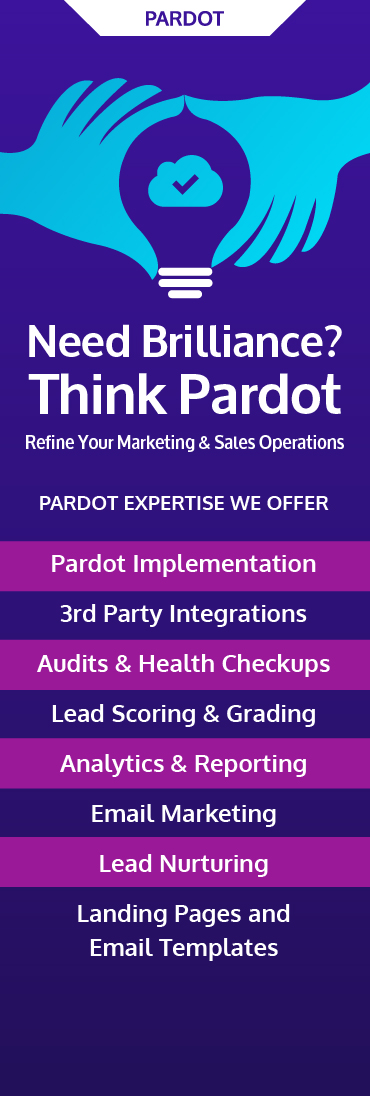What’s in a name? That’s what people say, right? Well, a lot is in a name, if you’re following what’s been going on with Salesforce recently.
Salesforce announced that it’s changing the name of some of its Marketing Cloud products during its world tour in Sydney.
Pardot, one of Salesforce’s marketing automation tools, will be now known as ‘Marketing Cloud Account Engagement.’
As we know, you can’t bring innovation without change, and Salesforce is all set to empower its customers with this new change.
So, how does rebranding impact the stakeholders?
Let’s unravel all about the rebranding of Pardot, the reason behind it, its pros and cons, and how it will impact the users.
What Does this Rebranding Mean and Its Pros and Cons
The reason behind the rebranding is part of an initiative called ‘Marketing Cloud Easy,’ which is a part of the ‘Salesforce Easy’ innovation goal. The goal is to make Marketing Cloud’s broad suite of products consistent and easy to understand by everyone.

The other reasons behind the name change were to:
- Make their next-gen Marketing Cloud experience consistent
- Make the new language more aligned with the language that marketers already use
- Make their Marketing Cloud a more unified and connected platform
- Increase flexibility across its cloud ecosystem that will allow for growth and innovation
- Convey the true capabilities of the platform
Salesforce tried to remove the binary B2B/B2C divide between Pardot and Marketing Cloud a few years ago. The truth of the matter is that Pardot has B2C customers whereas Salesforce Marketing Cloud has more transactional B2B customers.
Salesforce said that Pardot’s ‘Account Engagement’ will allow us to work side by side with Salesforce Marketing Cloud.
The new naming convention for the Marketing Cloud suite of products emphasizes that these products are part of the family. However, this name-change strategy will have some pros and cons.
Pros
-
- It will be easier to understand and reflect the capabilities of the product.
- It will be easier to align with the strategy of integrating Marketing Cloud into one unified solution around your customer.
- It will be flexible to describe the capabilities of the product that exist today while preparing for new product innovations.
Cons
- It will be hard for users and the Pardot community to unstick the legacy brand name.
- While the new naming system does have a unified nomenclature, it’s going to make the products really hard to talk about.
- ‘Account Engagement’ implies a go-to-market model where sales reps are identifying target accounts, and marketing is complimenting those efforts through an ABM strategy. And that does not reflect the needs of all Pardot users.
- It will make finding a partner more confusing. The AppExchange made a change to its filters a few days ago, presumably to adapt to this change to remove “Pardot” and “Datorama” from their filter criteria. Expertise in implementing one part of the Marketing Cloud does not always translate to other parts of the Marketing Cloud. In the short term, we think this change to the searchability of the AppExchange is going to really damage the ability of customers to find and vet qualified partners.
Things That Will Not Change After the Name Change
With the name change, there are a lot of things that are staying the same. They are:
- Product features and functionality as these will continue to grow and expand as part of the normal release cycle
- Pricing
- Packaging/bundles
- The exact SKU names on your Salesforce contract
When is This Going to Come into Effect?
It’s already happening. The first change will happen across the company’s website, marketing, and sales communications. Later this year, the updates will start changing in the products, the Salesforce official training and help material, their support pages, and their external pages.
For now, just be assured that despite the name changes, there are no immediate changes to login access, URLs, or product infrastructure.
Closing Thoughts from Grazitti’s Perspective
You may have noticed that the word Pardot appears on our website and resources a lot. We’ve built our platform with foundational Pardot integration, and going forward, we’re going to have to update a lot of our marketing and educational resources. However, we don’t foresee any changes to our processes or disruptions to the services we reliably provide.
Conclusion
With the name change, Salesforce is aligning with customer needs and meeting them where they are. Also, with this, you’ll be able to unify and activate customer data, connect inbound and outbound moments in real-time, engage leads and accounts, and intelligently optimize the customer journey.
Want to Take Your Pardot Operations Up a Notch? Let’s Talk!
Our Pardot experts will be happy to play a part in your Pardot journey and help you stay ahead of the curve. Just drop us a line at [email protected], and we’ll take it from there!












